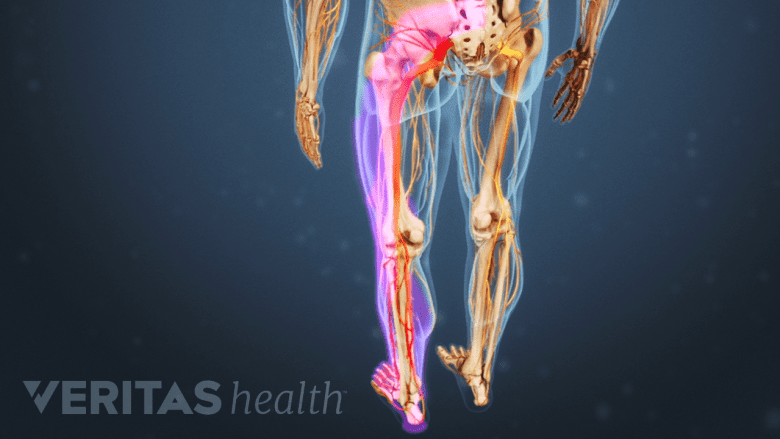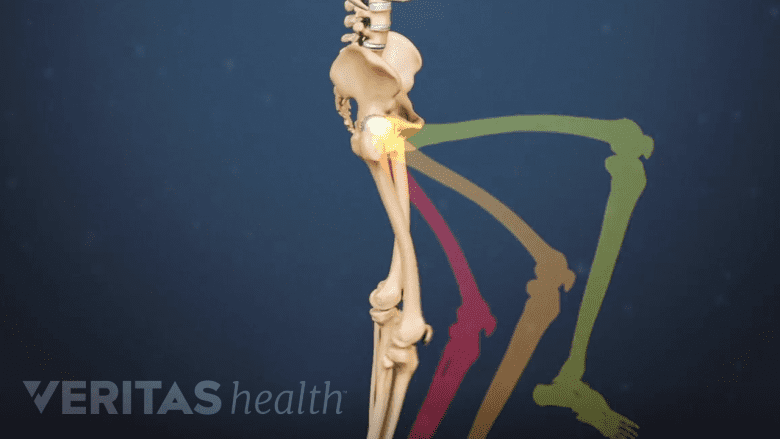Leg pain can be intermittent or constant and can range from a dull ache to a searing, throbbing, or burning sensation. Numbness may be felt like a loss of sensation or a cold, icy feeling in one or more areas of the leg.
Leg pain may be the symptom of a variety of underlying causes or conditions, and getting a correct diagnosis is essential to informing the most effective course of treatment.
In This Article:
- Leg Pain and Numbness: What Might These Symptoms Mean?
- Nerve Pain in the Leg
- Leg Pain Caused by Blood Vessel Issues
- Musculoskeletal Problems and Leg Pain
- Causes of Leg Pain Video
How Leg Pain Occurs

Leg pain often starts as a problem in the lumbar spine, or low back.
Leg pain may be caused due to a problem in the lower back, the pelvis, or a problem that originates within the leg. Common causes of pain in one or both legs include:
- Spinal nerve compression or irritation. Inflamed, irritated, or compressed nerve roots in the lumbar or sacral spine may cause radiculopathy or nerve pain, commonly called sciatica, in the leg and foot. Nerves may also be damaged along their path in the leg, causing peripheral neuropathy and leg pain.1Grimm BD, Blessinger BJ, Darden BV, Brigham CD, Kneisl JS, Laxer EB. Mimickers of Lumbar Radiculopathy. Journal of the American Academy of Orthopaedic Surgeons. 2015;23(1):7-17. doi:10.5435/jaaos-23-01-7
- Spinal cord compression. Narrowing of the spinal canal in the neck may apply pressure on the spinal cord, causing pain and numbness, typically in both legs.1Grimm BD, Blessinger BJ, Darden BV, Brigham CD, Kneisl JS, Laxer EB. Mimickers of Lumbar Radiculopathy. Journal of the American Academy of Orthopaedic Surgeons. 2015;23(1):7-17. doi:10.5435/jaaos-23-01-7
- Blood vessel conditions. Blocked arteries or veins in the leg may cause decreased blood supply, resulting in leg pain and numbness.1Grimm BD, Blessinger BJ, Darden BV, Brigham CD, Kneisl JS, Laxer EB. Mimickers of Lumbar Radiculopathy. Journal of the American Academy of Orthopaedic Surgeons. 2015;23(1):7-17. doi:10.5435/jaaos-23-01-7
- Pelvic and hip problems. Joint problems in the pelvis and hip regions, such as sacroiliac joint dysfunction or hip osteoarthritis, may cause leg pain; an associated nerve irritation may cause numbness. Pelvic muscle spasm, such as in piriformis syndrome, may cause pain to travel down along the leg with associated numbness and/or weakness.1Grimm BD, Blessinger BJ, Darden BV, Brigham CD, Kneisl JS, Laxer EB. Mimickers of Lumbar Radiculopathy. Journal of the American Academy of Orthopaedic Surgeons. 2015;23(1):7-17. doi:10.5435/jaaos-23-01-7
- Infection. Lyme disease,2Hanewinckel R, Ikram MA, Van Doorn PA. Peripheral neuropathies. In: Neuroepidemiology. Elsevier; 2016:263-282. doi:10.1016/b978-0-12-802973-2.00015-x bone and disc infection, such as osteomyelitis or spondylodiscitis, and viral infections, such as herpes zoster or HIV, are known to cause leg pain.1Grimm BD, Blessinger BJ, Darden BV, Brigham CD, Kneisl JS, Laxer EB. Mimickers of Lumbar Radiculopathy. Journal of the American Academy of Orthopaedic Surgeons. 2015;23(1):7-17. doi:10.5435/jaaos-23-01-7
- Systemic conditions. Endocrine and metabolic disorders, such as hypothyroidism and diabetes mellitus, may cause muscle and nerve damage in the legs that results in pain and numbness.2Hanewinckel R, Ikram MA, Van Doorn PA. Peripheral neuropathies. In: Neuroepidemiology. Elsevier; 2016:263-282. doi:10.1016/b978-0-12-802973-2.00015-x
- Cauda equina syndrome. Compression of the cauda equina (a group of spinal nerves that descend from the spinal cord in the lower back) may cause severe pain, numbness, and weakness in both legs.
- Tumors and cysts. The presence of growths and masses in the lower back, pelvis, or leg may compress blood vessels and/or nerves and lead to leg pain and numbness.
Leg pain may also develop due to strain, exercise, dehydration, aging, poor posture, hereditary factors, and/or occupation-related causes.
Symptoms Commonly Associated with Leg Pain

Nerve compression in the spine may cause leg weakness and a feeling of heaviness in the foot.
The most common symptoms that may accompany leg pain are:
- Weakness. Leg weakness commonly occurs when a lumbar and/or sacral spinal nerve is compressed. A feeling of heaviness3Davis D, Vasudevan A. Sciatica. [Updated 2019 Feb 28]. In: StatPearls [Internet]. Treasure Island (FL): StatPearls Publishing; 2019 Jan-. Available from: https://www.ncbi.nlm.nih.gov/books/NBK507908/ in the affected leg may make it difficult to lift the foot off the floor (foot drop).
- Altered sensation. When a nerve is affected, a pins-and-needles sensation, tingling, or other nerve-related sensations may occur in the affected leg.
- Foot pain. The leg pain may travel down into one or more areas of the foot, causing an ache or a burning pain. Foot weakness and/or numbness may also occur.
- Postural pain. Leg pain and numbness may increase with certain postures or activities, such as standing for a prolonged period of time, walking, climbing stairs, or standing up from a sitting position.
The above list includes several common symptoms that co-occur with leg pain but is not meant to be complete. It is possible for leg pain and/or numbness to be accompanied by signs of diabetes, cancer, certain types of nutritional deficiencies, and more.
Long-Term Outlook for Leg Pain
The course of leg pain depends on the underlying cause. Leg pain due to radiculopathy is common4Alexander CE, Varacallo M. Lumbosacral Radiculopathy. [Updated 2019 Mar 23]. In: StatPearls [Internet]. Treasure Island (FL): StatPearls Publishing; 2019 Jan-. Available from: https://www.ncbi.nlm.nih.gov/books/NBK430837/ and may be well managed with nonsurgical treatment, with 75% to 90% improvement in symptoms. If the pain becomes chronic and neurological symptoms such as weakness and numbness persist or worsen, surgery may be recommended.5Zhang X, Zhang Z, Wen J, Lu J, Sun Y, Sang D. The effectiveness of therapeutic strategies for patients with radiculopathy: A network meta-analysis. Mol Pain. 2018;14:1744806918768972. Published 2018 Apr 13. doi:10.1177/1744806918768972
The outlook for leg pain and numbness from other conditions depends on the severity and progression of the underlying cause. Treatment may include nonsurgical and/or surgical methods.
Read more about Understanding Sciatica Symptoms: Pins and Needles, Numbness, Icy, and Burning
When Leg Pain Is Serious
Severe leg pain and loss of bowel and/or bladder function is a medical emergency.
Leg pain may be associated with serious underlying conditions and need immediate treatment to preserve the function of the affected leg. Red-flag symptoms may include one or a combination of the following:
- Unexplained fever
- Severe pain and swelling
- Loss of appetite and/or unexplained weight loss
- Nausea
- Excruciating back pain
- Progressive leg numbness and/or weakness
- Loss of normal bowel and/or bladder function
These symptoms may indicate serious conditions such as infection, tumors, cauda equina syndrome, abdominal aortic aneurysm, or severe nerve damage.
See When Sciatica Pain Is a Medical Emergency
Leg pain may be treated by various types of medical professionals. Depending on the cause, doctors who typically treat leg pain may include primary care physicians, physiatrists, rheumatologists, neurologists, and neurosurgical and orthopedic spine surgeons, and chiropractors.
- 1 Grimm BD, Blessinger BJ, Darden BV, Brigham CD, Kneisl JS, Laxer EB. Mimickers of Lumbar Radiculopathy. Journal of the American Academy of Orthopaedic Surgeons. 2015;23(1):7-17. doi:10.5435/jaaos-23-01-7
- 2 Hanewinckel R, Ikram MA, Van Doorn PA. Peripheral neuropathies. In: Neuroepidemiology. Elsevier; 2016:263-282. doi:10.1016/b978-0-12-802973-2.00015-x
- 3 Davis D, Vasudevan A. Sciatica. [Updated 2019 Feb 28]. In: StatPearls [Internet]. Treasure Island (FL): StatPearls Publishing; 2019 Jan-. Available from: https://www.ncbi.nlm.nih.gov/books/NBK507908/
- 4 Alexander CE, Varacallo M. Lumbosacral Radiculopathy. [Updated 2019 Mar 23]. In: StatPearls [Internet]. Treasure Island (FL): StatPearls Publishing; 2019 Jan-. Available from: https://www.ncbi.nlm.nih.gov/books/NBK430837/
- 5 Zhang X, Zhang Z, Wen J, Lu J, Sun Y, Sang D. The effectiveness of therapeutic strategies for patients with radiculopathy: A network meta-analysis. Mol Pain. 2018;14:1744806918768972. Published 2018 Apr 13. doi:10.1177/1744806918768972

